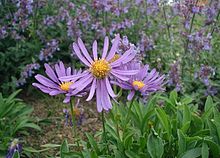|
Aster alpinus
Aster alpinus, the alpine aster or blue alpine daisy,[2] is a species of flowering plant in the family Asteraceae, native to the mountains of Europe (including the Alps), with a subspecies native to Canada and the United States.[3] This herbaceous perennial has purple, pink, white or blue flowers in summer.[4] Description Aster alpinus is a caespitose herbaceous perennial that grows 10–35 cm tall.[5] The bloom color may be blue, indigo, violet, white, or pink.[6] In the UK this plant has gained the Royal Horticultural Society's Award of Garden Merit.[7] Leaves are untoothed, lanceolate-spatulate, and basal. The Latin specific epithet alpinus means alpine and from high mountains above the timber line.[8] Distribution and habitatIt grows very slowly in clay, silt, loam, silty clay, and sandy clay. Its minimum pH scale is 6 and maximum pH scale is 7.5. Flowers are erect, and always solitary.[9] Aster alpinus is native to the mountains of Europe such as the Alps and Pyrenees.[8] Aster Alpinus is the only true aster growing in North America.[10] It does better in generally cooler climates. Usually it is adapted to clay, silt, loam, silty clay, sandy clay, clay loam, silt loam, sandy loam, silty clay loam and sandy clay loam soils, and prefers low fertility. The plant can tolerate only a minimum temperature of -28 °C / -18.4F after the occurrence of cell damage. It can survive medium heat of fire and requires at least 90 frost free days for proper growth.[citation needed] EcologyIt is herbaceous and attractive to bees, butterflies, and birds.[specify] ConservationNatureServe lists variety Aster alpinus var. vierhapperi as Secure Variety (T5) in Canada, but Critically Imperiled (S1) in Ontario and Vulnerable (S3) in Alberta. In the United States, it is Critically Imperiled (S1) in Colorado and Wyoming.[11] References
|
||||||||||||||||||||||||||||||||||||

